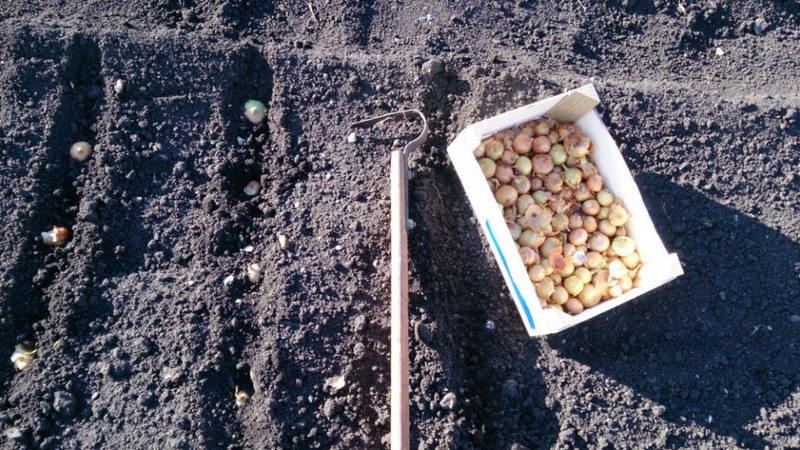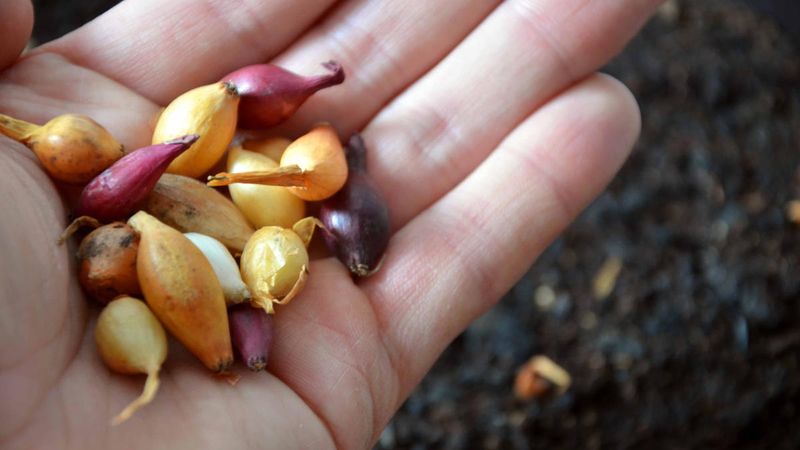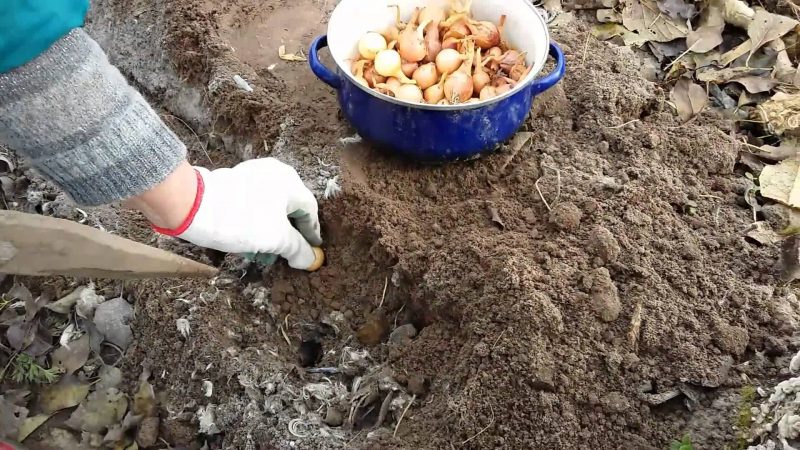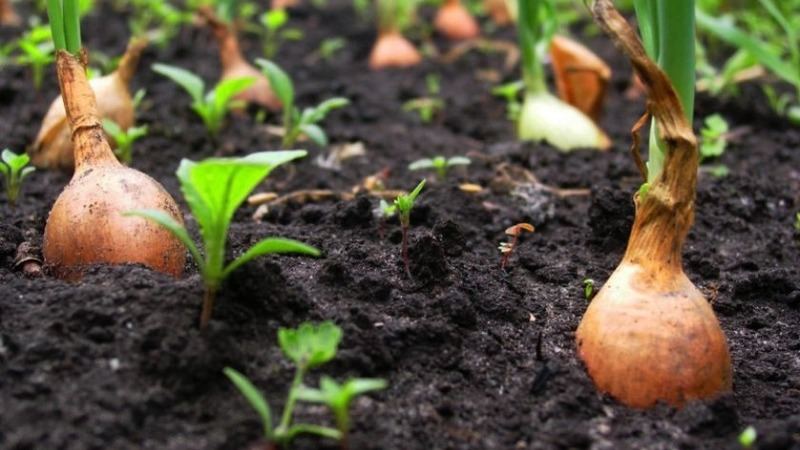Technology of planting onion sets in spring: how to plant and grow properly
Onions - a vegetable that is used all over the world, is added to most first and second courses, in some countries even to desserts. Many gardeners grow this crop on their site, most often from seedlings. This method is suitable for collecting turnips and greens. In both cases, there are nuances of landing and leaving.
Consider when and how to plant onion sets, what agricultural rules to follow in order to get a rich crop harvest.
The content of the article
When to plant onion sets in spring

Onion - a cold-resistant, unpretentious plant that is grown even in regions of risky farming.
In open ground, the culture is planted when the soil at a depth of 10 cm warms up to + 10 ... + 12 ° C. In such conditions, the onion begins to grow actively. Sevok not afraid of recurrent frosts, it stops developing only when it gets cold down to -3 ° C.
The optimal spring planting time depends on the region:
- regions with a southern climate - mid-April;
- regions with a temperate climate - end of April;
- northern regions - early May.
Onions are planted in unheated greenhouses 2 weeks earlier.
Lunar calendar for sevka for 2020:
| Month | Auspicious days | Unfavorable days |
| March | 4–6, 13–14, 22 | 8–10, 22–24 |
| April | 1-2, 10, 18-19, 28-29 | 7–9, 22–24 |
| May | 15–17,25–26 | 6–8, 21–23 |
Note! Onions on the windowsill for greens are grown at any time of the year.
Preparing for landing
To increase and accelerate the germination of seedlings, to increase resistance to diseases and negative environmental factors, it is prepared for planting. The first stage of preparation is warming up.
For this, the onions are dried in a warm place:
- the first 3 weeks - at a temperature of + 20 ... + 24 ° C;
- 10–12 hours - at + 30… + 40 ° С;
- again at room temperature.
Heating the vegetable will not let it go to the arrow.
Further processing includes several stages:
- Sorting. The planting material is sorted out. Damaged specimens with dark spots are removed. The sevok is sorted by size (separately up to 1.5 cm and more than 1.5 cm).
- Soak. The bulbs are wrapped in a cloth bag and immersed in water with a temperature of + 50 ° C for 10-15 minutes.
- Hardening. The planting material is immersed in cold water for 5 minutes.
- Growth stimulation. A nutrient solution is prepared ("Epin", aloe juice, honey water, "Solution"), in which the sevok is immersed for 6 hours.
- Protection against rot and bacteria. Onions are soaked for 2 hours in a solution made from 1 liter of water and 4 tsp. salt.
- Disinfection for fungal infections... The planting material is disinfected for 2 hours in a light pink solution of potassium permanganate or copper sulfate (2 tbsp. L. Per 10 l of water).
Onion sets are prepared a month before planting in open ground, since only warming up takes more than 3 weeks.
Site selection on the site

Onions are a light-loving crop that also grows in shaded areas, but shows the best results in sunny places in the garden.
The garden bed is chosen in an area where groundwater is not too close to the soil surface. Moreover, the plant does not like dry weather.
Sevok is planted after cabbage, nightshade, cucumbers. Unsuitable predecessors: other greens, carrots.
Attention! In the same place, the culture is planted no earlier than a year later. During the break, spinach, lettuce, radish, zucchini, carrots, beets are grown in the garden.
They observe the correct neighborhood of plants: if you plant carrots near the onion beds, then pests will less often infect both crops.
Soil preparation
Loose but nutritious soil is suitable for seeding. It must be slightly acidic, otherwise the risk of disease will increase.
In autumn, the soil is dug up, clearing it of plant residues. All insect larvae found are destroyed.
If the land is fertile, organic matter is not introduced in autumn. In this case, the onions are planted in the beds where crops have grown that require autumn manure application.
Humus (6 kg per 1 m2) and sand (2 kg per 1 m2) are added to clay soil in autumn. To reduce acidity, the earth is mixed with ash (0.5 kg per 1 m2). In addition, superphosphate (25 g per 1 m2) and potassium chloride (15 g per 1 m2) are added. The soil is mixed with fertilizers, leveling with a rake or digging.
Advice! At the end of summer or in autumn, after harvesting, siderates (lupine, rye) are sown on future onion beds to get nutritious and fertile soil in spring.
In the spring, the soil is dug up again, leveled with a rake and cleaned of weeds. Additionally, ammonium nitrate is added (20 g per 1 m2).
For disinfection, the earth is watered with a solution of copper sulfate (2 tablespoons per 1 bucket of boiling water) or "Fitosporin".
Head landing

For planting onions in the spring, different methods are chosen, depending on what they want to get: a turnip or greens.
For growing on a turnip, grooves are made 3-4 cm deep at a distance of 25 cm from each other. A little ash is poured into the bottom of the grooves.
The spacing between the bulbs depends on their size:
- up to 1 cm - 5 cm;
- from 1 cm to 1.5 cm - 8 cm;
- up to 2.5 cm - 10 cm.
The more planting material, the larger the vegetables will turn out.
Sevok is sprinkled with peat or garden soil, watered. In warm spring, the bulbs are planted so that the tails peep out above the surface. This will speed up the germination of vegetables. When the weather gets cold, the sevoks fall asleep completely so that it does not freeze.
Some summer residents plant the culture according to the Chinese method. To do this, at a distance of 20 cm, rows-ridges with a height of 15 cm are made. The bulbs are buried in them, the bases of which are gradually exposed, warmed up by the sun and dry quickly after precipitation. Often these vegetables are flattened.
Carrots or parsley are planted at the foot of the hills. Crops will mutually protect each other from pests.
By the way! The answer to the question of when it is best to plant onions also depends on the size of the seed: specimens up to 1 cm are sown 2 weeks earlier than larger ones.
Planting on greens
Sowing on greens differs from planting on a turnip: in this case, all the useful substances of the plant are given to the ground part.
Bulbs from 2 to 4 cm are suitable for forcing the feathers. They produce the thickest greens.
How to properly plant onion sets in spring:
- Intervalless method: vegetables are planted close to each other, without intervals between rows. It is important that the bases of the bulbs remain above the soil surface.
- Mostovoy: make grooves at a distance of 10 cm from each other. Sevok is planted in them close to each other. Planting depth does not change.
In the first case, the vegetables will not grow in size, but the greens will turn out to be thick and tasty.
Advice! To speed up the appearance of feathers and increase their number, cut off part of the base of the onion.
Intervallessly grown in winter sevok for greens at home. The bridge option is used for greenhouses.
Mixed fit

If there is not enough space on the site, a different scheme is used to obtain a turnip and greenery: the base of the onion is not cut off, grooves are made 7-8 cm wide, in them in 2 rows the bulbs are sown in a checkerboard pattern at a distance of 5 cm from each other.
The sevok is deepened so that it is completely underground. Some of the plantings are used to obtain feathers, and the other is used for turnips.
Advice! Each groove is additionally watered with "Fitosporin" to reduce the risk of infection of the culture with fungal infections.
Care
To get a good harvest of turnips or greens, the plantings are properly looked after. Although this culture is unpretentious, in unfavorable conditions the greens begin to turn yellow and lose their taste, and the turnip is bitter.
Onion care rules:
- The culture is watered once a week after planting with water at room temperature.In a rainy summer, the soil is moistened much less often.
- After each watering and rainfall, the soil in the beds and between the rows is loosened, while removing weeds. This will destroy the earth crust, which hinders air exchange and provokes rotting of the bulbs.
- Top dressing is applied three times per season: at the end of May, mid-June and 2-3 weeks after.
- To protect the bulbs from pests and negative environmental factors, the beds are mulched with straw, hay or humus. This will reduce the frequency of weeding and loosening, and retain moisture.
Nitrogen preparations are used in May. They accelerate crop growth and promote root development. The rest of the time, complex agents with potassium and phosphorus are used.
Greens and bulbs absorb harmful substances from the ground, so many farmers refuse to use chemicals when growing vegetables. In this case, herbal infusion will be the best fertilizer for planting. To prepare it, 3/4 of the buckets are filled with chopped nettles or other weeds without roots, seeds and signs of disease. The rest of the volume is poured with water at room temperature. The mixture is infused for 10 days in a warm place.
The resulting composition is filtered. For 10 liters of water, take 2 liters of infusion, add 1 tbsp. ash. For 1 m2 of land, 1 liter of funds is spent.

Diseases and pests
Onions hit various diseases:
- Downy mildew... The leaves are covered with light green spots, on which a purple bloom soon appears. Often the disease is accompanied by the defeat of a semi-parasitic black fungus. As a result, the feathers turn yellow and dry completely, the turnips do not develop and are deformed. For treatment and prophylaxis, use chemicals (Fitosporin), pharmacy (light pink solution of potassium permanganate), homemade (add 10 drops of iodine to 1 liter of skim milk or whey).
- Gray rot. Onions are affected in the second half of summer, when the greens are already beginning to dry out. It develops during storage of the crop, leading to the appearance of grayish rot in the upper part of the vegetables. The disease is not cured.
- Bacteriosis. Infects plants in soil, but manifests itself during storage. A brown, fetid rot is found in the middle of the turnip. The disease does not respond to treatment.
- Fusarium rot... The onion bottoms are covered with a white bloom, gradually begin to rot, which leads to the death of the plant. The diseased vegetable is removed, the beds are watered with a 1% solution of Bordeaux mixture.
- Bacterial rot... It affects the culture in the soil, but manifests itself during storage, when the core of the turnip rots out. As a preventive measure, the soil is treated with the "HOM" preparation.
Most of these diseases are not cured. To prevent them from arising, the rules of crop rotation are observed, the irrigation regime, the soil and planting material are disinfected.
No less dangerous for bows peststhat lead to the death of the crop:
- Onion fly. Eats plants, looks like an ordinary fly. To combat insects, planting is watered with a mixture prepared from 10 liters of water, 10 drops of iodine and 1 tbsp. l. ammonia.
- Onion mite... Small white arachnids infect turnips and feathers, causing them to dry out and die. Without the use of chemicals, the fight against the pest is impossible. For prevention, once every 2 weeks, the beds are watered with nettle broth.
- Onion thrips... It lays the larvae in the feathers of the plant, they become covered with white spots, and then dry out. To combat the pest, plantings are sprayed with an infusion of celandine (1/3 of a bucket of celandine is poured with water and insisted for 2 days).
Conclusion
Growing seedlings is a simple process that even a novice gardener can handle. Although the culture is unpretentious, with improper watering and non-compliance with disease prevention, the vegetable infects infections and pests.
To get a rich harvest of turnips or greens, the seedlings are preheated, soaked, hardened and disinfected. They are planted in suitable soil, taking into account crop rotation.